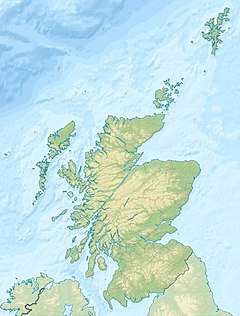This article has multiple issues. Please help improve it or discuss these issues on the talk page. (Learn how and when to remove these messages)
|
| Craigenputtock House and Estate | |
|---|---|
| The Craig | |
 Painting by George Moir 1829 | |
| Location | Dumfries and Galloway |
| Coordinates | 55°7′13.44″N 3°55′41.52″W / 55.1204000°N 3.9282000°W |
| Area | 800 acres (324 ha) |
| First occupied | 15th century |
| Built | 18th century (completed) |
| Built for | The family of Welsh |
| Current residents | Carter-Campbell of Possil |
| Architectural style(s) | Georgian |
Listed Building – Category B | |
Craigenputtock (usually spelled by the Carlyles as Craigenputtoch)[1] is an estate in Scotland where Thomas Carlyle lived from 1828 to 1834. He wrote several of his early works there, including Sartor Resartus.
The estate's name incorporates the Scots words craig, meaning hill, referring in this case to a whinstone hill, and puttock, or small hawk.[2] Craigenputtock occupies 800 acres (320 hectares) of farmland in the civil parish of Dunscore in Dumfriesshire, within the District Council Region of Dumfries and Galloway. The principal residence on the grounds is a two-storey, four bedroomed Georgian Country House (category B listed). The estate also comprises two cottages, a farmstead, 315 acres (127 ha) of moorland hill rising to 1,000 ft (300 m) above sea level, and 350 acres (140 ha) of inbye ground of which 40 acres (16 ha) is arable, ploughable land and 135 acres (55 ha) is woodland.
It was the property for generations (circa 1500) of the family Welsh, and eventually that of their heiress, Jane Baillie Welsh Carlyle (1801–1866) (descended on the paternal side from Elizabeth, the youngest daughter of John Knox), which the Carlyles made their dwelling-house in 1828, where they remained for seven years (before moving to Carlyle's House in Cheyne Row, London), and where Sartor Resartus was written. The property was bequeathed by Thomas Carlyle to the Edinburgh University on his death in 1881. It is now home to the Carter-Campbell family, and managed by the C.C.C. (Carlyle Craigenputtock Circle).
It is certain that for living and thinking in, I have never since found in the world a place so favourable. How blessed might poor mortals be in the straitest circumstances if their wisdom and fidelity to heaven and to one another were adequately great!
— Thomas Carlyle on Craigenputtock
- ^ Cumming, Mark, ed. (2004). "Craigenputtoch". The Carlyle Encyclopedia. Madison and Teaneck, NJ: Fairleigh Dickinson University Press. p. 105.
- ^ "Dictionary of the Scots Language:: SND :: puttock".
